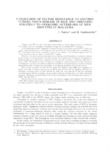Utilization of Vector Resistance to Control Tungro Virus Disease in Rice and Breeding Strategy to Overcome Outbreaks of New Biotypes in Malaysia
Tropical agriculture research series : proceedings of a symposium on tropical agriculture researches
| ISSN | 03889386 |
|---|---|
| 書誌レコードID(総合目録DB) | AA00870529 |

本文フルテキスト
tars19-_229-235.pdf1.19 MB
Tungro virus (RTV) is one of the most serious diseases of rice (Oryza sativa L.) in Malaysia. This report aims at outlining a breeding strategy for promoting RTV resistance.
Green leafhopper (GLH: Nephotettix virescens Distant) is the main vector of RTV. There was a very close correlation (r=-0.763) between the mortality of GLH nymphs and susceptibility to RTV infection under forced inoculation tests on host plants. This finding suggests that the vector resistance can be used to control RTV disease.
However, the occurrence of outbreaks of new biotypes after the release of varieties resistant to the vector is a serious problem. To alleviate this shortcoming the authors first developed five GLH biotypes which were able to reproduce on the resistant varieties, i.e. Pankhari 203, ASD 7, Ptb 8, TAPL 796 and IR 42. The existence of a specific or vertical resistance of rice varieties to GLH biotypes was observed. Pankhari 203, Ptb 8 and IR 42 were each resistant to all the biotypes developed on other varieties but susceptible to the biotype developed on the same variety.
Most of the resistant varieties or lines from West Malaysia and IRRI were considered to harbor the same resistance gene as that of IR 42 derived from Ptb 18. Pankhari 203 had one dominant resistance gene to GLH and IR 36 while the sister line IR 42 had two dominant resistance genes. Of the two genes, one was highly resistant and the other was only moderately resistant. The highly resistant gene of IR 42 was independent of the resistance genes present in TAPL 796 and ASD 7.
On the basis of the results of this study, the authors suggest that Pankhari 203, Ptb 8 and TAPL 796 should be used as gene sources of GLH resistance after the breakdown of IR 42 which has been planted in Malaysia for several years.
Green leafhopper (GLH: Nephotettix virescens Distant) is the main vector of RTV. There was a very close correlation (r=-0.763) between the mortality of GLH nymphs and susceptibility to RTV infection under forced inoculation tests on host plants. This finding suggests that the vector resistance can be used to control RTV disease.
However, the occurrence of outbreaks of new biotypes after the release of varieties resistant to the vector is a serious problem. To alleviate this shortcoming the authors first developed five GLH biotypes which were able to reproduce on the resistant varieties, i.e. Pankhari 203, ASD 7, Ptb 8, TAPL 796 and IR 42. The existence of a specific or vertical resistance of rice varieties to GLH biotypes was observed. Pankhari 203, Ptb 8 and IR 42 were each resistant to all the biotypes developed on other varieties but susceptible to the biotype developed on the same variety.
Most of the resistant varieties or lines from West Malaysia and IRRI were considered to harbor the same resistance gene as that of IR 42 derived from Ptb 18. Pankhari 203 had one dominant resistance gene to GLH and IR 36 while the sister line IR 42 had two dominant resistance genes. Of the two genes, one was highly resistant and the other was only moderately resistant. The highly resistant gene of IR 42 was independent of the resistance genes present in TAPL 796 and ASD 7.
On the basis of the results of this study, the authors suggest that Pankhari 203, Ptb 8 and TAPL 796 should be used as gene sources of GLH resistance after the breakdown of IR 42 which has been planted in Malaysia for several years.
| 刊行年月日 | |
|---|---|
| 作成者 | I. Takita H. Habibuddin |
| 公開者 | Japan International Research Center for Agricultural Sciences |
| 巻 | 19 |
| 開始ページ | 229 |
| 終了ページ | 235 |
| 言語 | eng |
